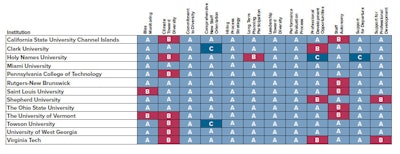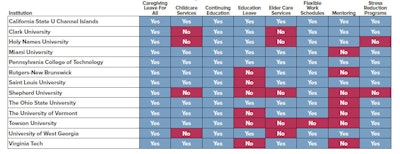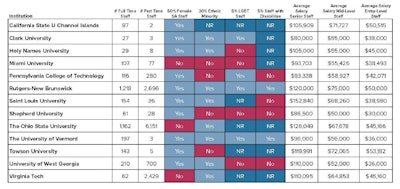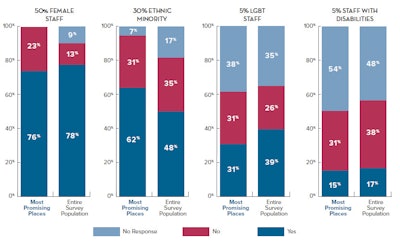Now in its fifth year, Most Promising Places to Work in Student Affairs (MPPWSA) is a national recognition that celebrates student affairs workplaces that are vibrant, diverse, supportive and committed to staff work-life balance, professional development and inclusive excellence. MPPWSA offers institutional leaders information that can be used to improve practices across their student affairs community, while also serving as a useful tool for employers, career services staff and job seekers across the country.
The top 13 Most Promising Places to Work in Student Affairs for 2018 were identified based on results from this year’s survey using an algorithm that considers weighted data for all points highlighted in this issue. This year’s MPPWSA institutions are listed here alphabetically.
Find out more information on the 2018 Most Promising Places to Work in Student Affairs in our March 8, 2018 edition.
| Institution | Senior Student Affairs Officer | Location | Level | Control | Enrollment |
|---|---|---|---|---|---|
| California State University Channel Islands | Dr. Wm. Gregory Sawyer | Camarillo, CA | 4-Yr | Public | 6,167 |
| Clark University | Dr. Francy Magee | Worcester, MA | 4-Yr | Private | 3,094 |
| Holy Names University | Michael Miller | Oakland, CA | 4-Yr | Private | 866 |
| Miami University | Dr. Jayne Brownell | Oxford, OH | 4-Yr | Public | 8,437 |
| Pennsylvania College of Technology | Elliott Strickland | Williamsport, PA | 4-Yr | Public | 5,465 |
| Rutgers-New Brunswick | Dr. Felicia E. McGinty | New Brunswick, NJ | 4-Yr | Public | 37,364 |
| Saint Louis University | Dr. Kent Porterfield | St. Louis, MO | 4-Yr | Private | 13,287 |
| Shepherd University | Dr. Thomas C. Segar | Shepherdstown, WV | 4-Yr | Public | 3,779 |
| The Ohio State University | Dr. Javaune Adams-Gaston | Columbus, OH | 4-Yr | Public | 66,444 |
| The University of Vermont | Dr. Annie Stevens | Burlington, VT | 4-Yr | Public | 11,898 |
| Towson University | Dr. Deb Moriarty | Towson, MD | 4-Yr | Public | 22,284 |
| University of West Georgia | Dr. Scot Lingrell | Carrollton, GA | 4-Yr | Public | 13,308 |
| Virginia Tech | Dr. Patricia Perillo | Blacksburg, VA | 4-Yr | Public | 30,598 |
PROJECT TEAM BIOGRAPHIES
Dr. Terrell Lamont Strayhorn (principal investigator) is a professor and founding CEO of Do Good Work Educational Consulting, LLC, a research firm that specializes in translating research discoveries to improve policy and practice, as a way of ensuring all students’ success. Author of 10 books, more than 200 journal articles, chapters, and reports, Strayhorn is an internationally known student success expert and public speaker.
Dr. Royel Montel Johnson (co-principal investigator) is assistant professor of higher education at Pennsylvania State University, within the Department of Educational Policy Studies. His research focuses on major policy- and practice-relevant issues in education, such as college access and success; race, equity and diversity; and student learning and development. He is co-editor of a forthcoming book on historically Black colleges and universities.
ABOUT THE STUDY
This study was first proposed by Diverse: Issues in Higher Education as a possible partnership with the American College Personnel Association (ACPA) in 2011.
Dr. Terrell Strayhorn was commissioned by ACPA and Diverse: Issues in Higher Education to serve as the project’s principal investigator. In this role, Strayhorn developed the Most Promising Places to Work in Student Affairs (MPPWSA) Survey in consultation with experts on the project’s advisory board. The original survey was pilot-tested with a small sample of non-ACPA member institutions; feedback from the pilot-test helped to clarify survey items, correct logic sequencing and determine the utility of our scoring algorithm.
The purpose of this commissioned study was to examine the extent to which diversity and inclusion permeates aspects of various divisions of student affairs (or equivalent) at participating ACPA-member institutions across the globe, including administrative structures, commitments, work environments and staffing practices.
PROMISING PLACES TO WORK IN STUDENT AFFAIRS ADVISORY BOARD
Tracey Cameron, Ph.D.
Assistant Dean of Intercultural Education
Director Harambee House
Advisor to Student of African Descent
Wellesley College
Stan Carpenter, Ph.D.
Dean
College of Education
Texas State University
Kristen A. Renn, Ph.D.
Professor of Higher, Adult, & Lifelong Education
Michigan State University
Joan B. Hirt, Ph.D.
Professor, Educational Leadership and Policy Studies
School of Education
College of Liberal Arts and Human Sciences
Virginia Polytechnic Institute and State University
Sue Saunders, Ph.D.
Program Coordinator, Higher Education and Student Affairs
Administration
Extension Professor, Department of Educational Leadership
Neag School of Education
Promising Practices
Building on the success of previous years, we are excited to include a set of “promising practices” in this year’s report for Most Promising Places to Work in Student Affairs. As the MPPWSA project matures each year, we learn more and more about what various institutions are doing to increase staff diversity, to foster a sense of belonging and to equip college student educators with the ability to work with students. In previous editions of Diverse, we shared practices that hold promise for achieving the outcomes we desire with student affairs staff. (For more, see Diverse, March 2016 or 2017.) This year, we present the growing list of promising practices.
- A Culture of Evidence Based Practice
- Engagement in the Broader Profession
- Commitment to Inclusive Excellence
- Organizational Mindset for Learning & Improvement
The American College Personnel Association (ACPA), along with several other national professional associations, acknowledges the important role that research, theory and scholarship play in effective student affairs practice. So much so that the most recent Professional Competencies and Standards Report affirms the importance of evidence-based practice, which is one of the “promising practices” that distinguish MPPWSA institutions from their peers. Our conversations and site visits revealed an obvious ethos within these divisions of student affairs that pressed for
the use of research, theory and scholarship in everyday practice.
More than just a one-off mention of Alexander Astin’s “involvement theory” or a drive-by lecture from a highly-acclaimed speaker, MPPWSA institutions were largely characterized in both structure and form as workplaces that infused the collection, use and sharing of evidence or “provocative information” consistently throughout the entire division. For instance, student affairs staff at St. Louis University get the message from “day one that research
and evidence are critical for eff ective practice” as part of their onboarding process, which is also reflected in the division’s guiding documents and policies. SLU’s Division of Student Development hiring plan includes multiple references to published literature on effective practices for building multicultural competence, sense
of belonging and power/oppression.
Although many MPPWSA institutions are marked by a culture for evidence-based practice — where decisions begin with questions about data, information and current research — the institutions we visited were quite different in “how” they created this distinctive culture. Some did this through book clubs, affinity groups, rubrics and box-whisker plots, while others preserved a culture of evidence through guest speakers, webinars, strong partnerships with graduate prep programs on campus and so on. At the University of West Georgia (UWG), Vice President Scott
Lingrell and his team have developed a literature review, chockfull of APA citations, that supports the division’s five strategic imperatives. The school requires all new staff to read the review. UWG and other featured campuses perpetuate the culture of evidence by incentivizing staff to justify funding requests, new programs and work success using data, assessments and the science of college impacts. We were impressed by the explicit mention of theory, evaluations and “value-added models” in these student affairs workplaces. In many ways, MPPWSA institutions possess evidence-based cultures that compel staff to marshal of their impact on students, which makes them a viable partner to other units on campus in ensuring student success!
If we learned anything from our conversations with and visits to several MPPWSA institutions, it is that staff at these institutions feel as if they belong in the campus, division and broader profession. Time and time again, staff at MPPWSA institutions emphasized that they were encouraged to be actively engaged in the broader profession. Through stories and anecdotes, staff shared how SSAOs at Most Promising Places provided strong support to their direct reports and all staff to get involved in various professional associations, such as ACPA, NASPA, and functional area-specific groups like those in campus activities, academic advising and housing. Not only did senior leaders encourage active involvement in professional roles and responsibilities but they also role-modeled the importance of such activities by being actively involved in national leadership, consultancies, advisories and committees themselves. For instance, senior leaders and staff at Most Promising Places include former ACPA presidents, editors of professional journals and magazines, conference program chairs, heads of counseling associations and even members of national advisory boards.
Engagement in the broader profession was encouraged in other ways as well. For instance, some staff shared that they received “release time” from some work responsibilities in order to assume responsibilities in the larger profession. While serving as program chair for a national student affairs association, one staff member at a large public university was given “half a day per week” to concentrate on those duties, access to resources that support their success in that role, and even travel support, when needed, to meet with other members of the program team. It also became clear that staff are socialized to this way of life from the very first day. Many talked about how their on-boarding process included explicit mention of them joining the “campus community, the division’s team and the profession of student affairs.” Connecting the dots for some staff was particularly helpful for introducing
them to the profession at large.
Indeed, SSAOs at MPPWSA campuses understand the value that active engagement in the broader profession adds to the quality of programs and services provided by the division. They also see their role, at least in part, as furthering the development of new, mid-, and other senior-level professionals in the field of student affairs. In that way, their division becomes another training ground for competent staff to apply theory to practice and to become familiar with the norms, values and expectations of the larger profession.
Beyond the development of taskforces and strategic plans for achieving diversity or inclusive excellence within their divisions, senior leaders at MPPWSA institutions demonstrated deep commitment to inclusive excellence in the day-to-day operations of the division. For example, Saint Louis University’s vice president for student development, Dr. Kent Porterfield, commissioned a committee in 2011 to develop a comprehensive guide for the recruitment and retention of diverse staff. Grounded in empirical research on multiculturalism and social justice, as well as best practices in the field, SLU’s guide offers hiring committees and supervisors actionable items to follow to achieve the diversity they envision for their unit. As an example, staff are encouraged to discuss hiring goals with human resources (HR) recruiters and to request full view of candidates without pre-screening. This strategy helps ensure that all candidates are carefully considered in an equitable manner.
Ensuring inclusive excellence in student affairs is hard work. It requires that institutions move beyond rhetoric — the mere acknowledgment that diversity is important — to action. Leaders at MPPWSA institutions have taken bold new steps for sustained transformational change within their division. We encourage SSAOs across the country to also engage in the necessary, and sometimes difficult, decision-making that demonstrates an abiding commitment to inclusive excellence. It’s hard work but hard work is no excuse for retreat!
Carol Dweck, a renowned psychologist, is best known for her work on mindset as a psychological trait. In her book Mindset: The New Psychology of Success, she illustrates the power of growth mindedness or a set of beliefs that create success through effort, motivation and persistence. Growth mindsets stay open to learning, discovery, feedback and continuous improvement. Interestingly, we discovered a common theme among Most Promising Places — an organizational mindset focused on learning and improvement. Virtually all of the senior leaders with whom we spoke echoed words reminiscent of Dweck’s book: “We’re a division in the making … we’re not perfect, but striving” or, “If you’re looking for a perfect division, then we’re not it … but if you’re looking for a place to learn and grow, then we’re an exciting place to be.” Emphasizing the importance of learning, honest assessment, continuous improvement, feedback loops and admitting “gaps or weaknesses” seemed to permeate the division and how staff thought about their work on campus. To cultivate learning as part of this effort to establish an organizational mindset, many divisions took strides to encourage learning and professional growth of staff. For instance, at Virginia Tech (VT), all staff within student affairs “have at least 7 times a year to come together to learn with others in the division” about the state of affairs in the field, best practices, and what can be done to improve the work of student affairs. The Division of Student Affairs at VT, under the leadership of former ACPA President Dr. Patty Perillo, offers staff breakfast meetings several times per year where all staff — “even front line workers and administrative assistants” — come together to acquire new information about aspirations for learning, StrengthsQuest, and to recognize high-performing staff, faculty and students on campus, one of many mechanisms for providing performance feedback. Incidentally, VT is the first university in the country to use StrengthsQuest campus-wide.
Not only that, but divisional leaders at many MPPWSA campuses work with senior staff to extend learning opportunities for the entire division. For example, at several campuses we visited, senior leaders provide funding ($500-1,000) to host speakers or presenters on campus, encourage staff attendance at conferences and their participation in webinars. Virtually all campuses provide annual performance evaluations, in addition to constructive feedback about staff work as a way of encouraging self-discovery, personal learning — e.g., social media trainings, graduate training — and achievement. In fact, one year’s theme at the University of West Georgia was “The Learning Year,” according to UWG President Dr. Kyle Marrero. An organizational mindset for learning and improvement showed up in other ways too. At Virginia Tech, the Vice President of Student Affairs (Patty Perillo) has “office hours” available to meet with any staff member about any topic — what her staff now affectionately call “Patty-gogy” (a spin on “pedagogy”) or simply teaching and learning with Patty. One staff member remarked, “It’s a real conversation, sitting in a circle, touching on real-life topics … you feel like you really get to know people including senior leaders … what matters and what are we about.” At both the University of West Georgia and Ohio State University, student affairs staff are encourage to learn, grow, take chances and even experiment with new approaches to supporting students. Ohio State is part of the University Innovation Alliance (UIA), an 11-campus cluster committed to testing and scaling effective interventions that “may or may not work,” but staff are advised not to internalize “muted effects” as failure but rather as a wonderful opportunity to learn more about their students, themselves and what really works. In many ways, MPPWSA institutions reflect organizational mindsets that make the division a safe space for learning, discovery, experimentation and continuous improvement!
Diversity Policies
Diversity is a hallmark of American higher education, even in student affairs divisions. Most Promising Places have many diversity policies in place that guide workplace behaviors and support staff worklife. This table presents a summary.

Diversity Benefits

Staff Profile
The Most Promising Places to Work in Student Affairs are promising because of the amazing staff members that constitute the team. The following charts and tables summarize data, facts, and figures about this year’s Most Promising Places and how they stack up against all schools surveyed. 
